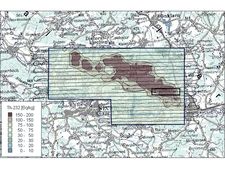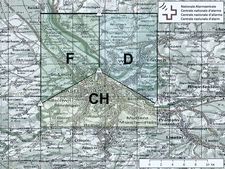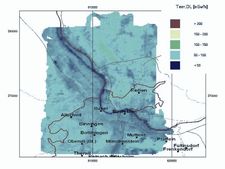-
Topics
subnavigation
Topics
Electromagnetic fields
- What are electromagnetic fields?
- Static and low-frequency fields
- Radiation protection relating to the expansion of the national grid
- High-frequency fields
- Radiation protection in mobile communication
Optical radiation
Ionising radiation
- What is ionising radiation?
- Radioactivity in the environment
- Applications in medicine
- Applications in daily life and in technology
- Effects
- What are the effects of radiation?
- Effects of selected radioactive materials
- Consequences of a radiation accident
- Cancer and leukaemia
- Genetic radiation effects
- Individual radiosensitivity
- Epidemiology of radiation-induced diseases
- Ionising radiation: positive effects?
- Risk estimation and assessment
- Radiation protection
- Nuclear accident management
- Service offers
-
The BfS
subnavigation
The BfS
- About us
- Science and research
- Laws and regulations
- BfS Topics in the Bundestag
- Links
International cooperation in the field of airborne gamma spectrometry
- BfS performs regular national measuring exercises and has also participated in several international measuring campaigns in cooperation with the German Federal Police since the mid-1990s.
- Cooperation with Germany’s neighbours France and Switzerland, in particular, has been intensified since 2000.
The Federal Office for Radiation Protection (BfS) performs regular national measuring exercises and has also participated in several international measuring campaigns in cooperation with the German Federal Police since the mid-1990s.
The objectives of such international measuring campaigns are:
- Harmonizing the different national measuring strategies;
- Providing for external quality assurance by means of a comparison of the measuring results;
- Rapidly combining the measured data in order to create joint contamination maps.
Intensified cooperation since 2000
Cooperation with Germany’s neighbours France (CEA) and Switzerland (National Emergency Operations Centre), in particular, has been intensified since 2000. In this context, the following joint exercises were performed:
- in 2003, a measuring exercise in Saxony (Germany) involving German and French experts;
- in 2004, a measuring exercise in Béziers (France) involving German and French experts;
- in 2007, a measuring exercise in Zurich and Basel (Switzerland) involving German, French and Swiss experts;
- in 2009, a measuring exercise in Munich (Germany) involving German, French and Swiss experts;
- in 2015, a Measuring exercise in Chemnitz (Germany) involving German, Czech, French and Swiss experts,
- in 2017, a Measuring exercise in Zurich (Switzerland) involving German, Czech, French and Swiss experts.
Measuring exercises since 2015
International measuring exercises since 2015
Since 2011, BfS publishes detailed reports with respect to the major national and international measuring exercises and the corresponding results and makes them available on the internet. International campaigns were performed in Saxony/Thuringia and the Czech Republic (2015) and in Switzerland (2017). Please find more detailed information on these international measuring exercises at "Measurement exercises and the corresponding results in detail":
Measuring campaign 2009
Measuring campaign in Germany in 2009
In order to enhance the cooperation between measuring teams from France, Switzerland and Germany, an aero measuring campaign was performed in the Munich area in 2009. Measurements focused on the following tasks:
- Finding radioactive sources placed in vehicles that were driven over a specific distance within a specific period of time;
- Finding hidden radioactive sources;
- Large-scale mapping of natural radiation anomalies.

![]() Spatial distribution of the mass-related activities of thorium-232 in the survey area near the town of Neunburg vorm Wald (German team)
Spatial distribution of the mass-related activities of thorium-232 in the survey area near the town of Neunburg vorm Wald (German team)
An area covering 90 square kilometres near the town of Neunburg vorm Wald was examined for the third task and a map was created showing the radionuclides thorium-232, bismuth-214, potassium-40 and the gamma dose rate. The teams had to meet the following requirements: 3 hours operation time in the survey area, flying at a height of 100 metres and keeping a distance of 370 metres between flight paths.

![]() Comparison of the averaged mass-related activities of potassium-40, bismuth-214, thorium-232 and the gamma dose rate, determined by the three teams
Comparison of the averaged mass-related activities of potassium-40, bismuth-214, thorium-232 and the gamma dose rate, determined by the three teams
The teams transmitted the measured data to the operation centre in Munich soon after they had completed the measuring flights in the relevant areas. The measured data was combined with geographical maps, as illustrated in the figure on the left-hand side. The figure on the right-hand side shows the averaged mass-related activity concentrations for the radionuclides to be measured in the survey area. The measured results are comparable and in good agreement, taking the methodological uncertainty into account.
According to the participating experts and observers, in particular this part of the exercise has shown that helicopter-based measuring systems are extremely powerful in identifying and localizing large-scale environmental contamination.
Measuring campaign 2007
Measuring campaign in Switzerland in 2007
In August 2007, the tri-national measuring campaign “ARM07” was conducted in the area of Zurich and Basel. This measuring exercise was focused on:
- Radiological mapping of the areas surrounding the nuclear installations of Gösgen and Mühleberg (comparison measurements);
- Vehicle- and helicopter-based search for several radioactive sources placed on the premises of the freight terminal of Basel railway station in Muttenz; and
- Joint radiological mapping ("composite mapping") of the border triangle near Basel.
The survey area chosen for the radiological mapping activities comprised three measuring areas (with roughly the same dimensions) situated on the territories of the three participating states, as can be seen in the figure on the left-hand side (F is for France, D for Germany and CH for Switzerland). The spatial distribution of the gamma dose rate is shown in the figure on the right-hand side.

![]() Measuring areas for composite mapping around Basel
Source: Measuring flights 2007, 27 - 30 August (National Emergency Operations Centre, Switzerland)
Measuring areas for composite mapping around Basel
Source: Measuring flights 2007, 27 - 30 August (National Emergency Operations Centre, Switzerland)

![]() Terrestrial portion of the gamma dose rate
Source: Measuring flights 2007, 27 - 30 August (National Emergency Operations Centre, Switzerland)
Terrestrial portion of the gamma dose rate
Source: Measuring flights 2007, 27 - 30 August (National Emergency Operations Centre, Switzerland)
International Aero-gamma Workshop
In October 2010, the Federal Office for Radiation Protection arranged and coordinated an international workshop on the state-of-the-art of science and technology in the field of aero-gamma spectrometry. 50 participants from 11 European countries and the United States attended the workshop that was held in Berlin.
The participants presented and discussed the results obtained in measuring campaigns over the last ten years and the methodological and technical advancements in the measuring technique.
EU research activities and support for international institutions
Between 2000 and 2002, the Federal Office for Radiation Protection and the Federal Police participated in the research project "European Calibration and Coordination of Mobile and Airborne Gamma Spectrometry (ECCOMAGS)", together with eight European teams for helicopter-borne measurements. The project is funded by the European Commission.
Between 2004 and 2008, the Federal Office for Radiation Protection also supported the Comprehensive Nuclear-Test-Ban Treaty Organization (CTBTO) as consultant for the integration of helicopter- and vehicle-based gamma-spectrometric measuring systems with the aim of detecting underground nuclear weapons testing, and BfS assisted in the performance of measuring exercises.
State of 2017.09.21


